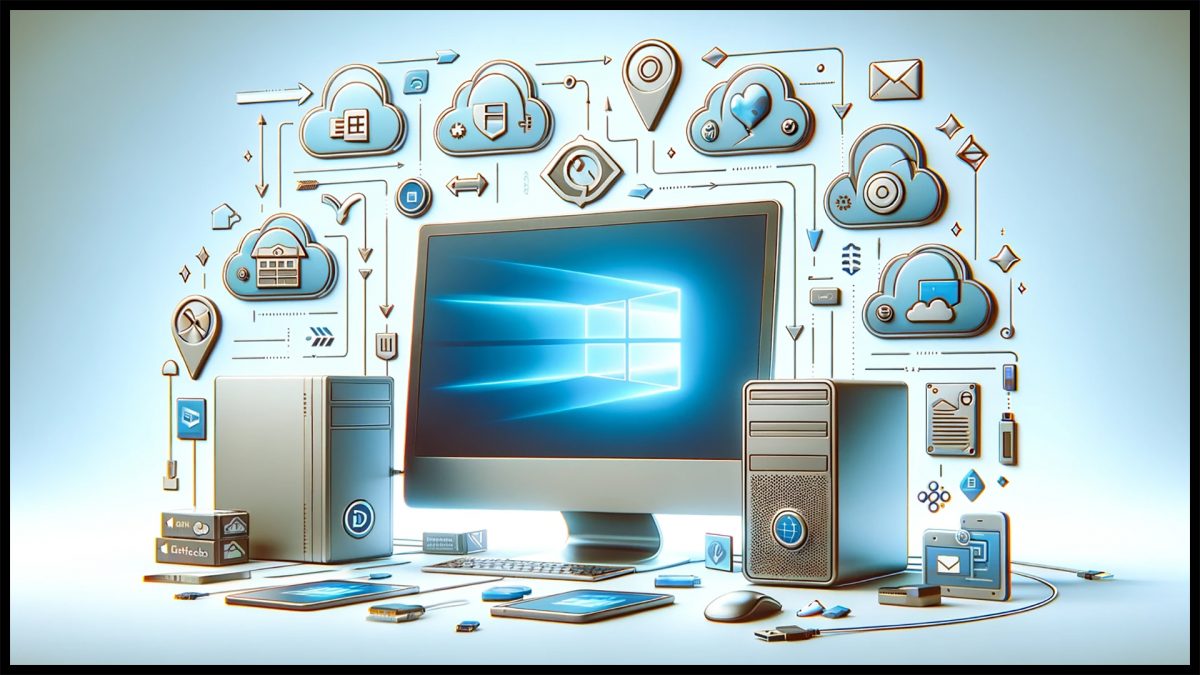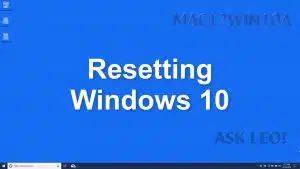It all starts with preparation.

Yes, there is.
It’s not what most people expect or even want, but it’s guaranteed to not mess up the new installation. The results will be exactly what you’re looking for.
It just requires some preparation.
Become a Patron of Ask Leo! and go ad-free!

Transferring data across a clean install
Prepare by backing up data to an external drive or cloud service. Ideally, take an image backup of the entire machine so as not to overlook anything. After the new Windows installation, reinstall applications using their original media or downloads and restore your data from the backup.
A “clean” install
A “clean” install of Windows treats the system hard disk as if it were empty. For example if you replace the hard disk with a truly empty one, or you want to erase everything because you no longer trust that’s there due to malware.
If it’s not empty, then a clean install either actively erases the disk by reformatting it before installing, or it just ignores everything on the disk, overwriting it all as it installs.
That means:
- Everything on the disk is ignored or erased.
- Your previous data is gone.
A new machine?
You’ll notice that this is essentially what you have when you get a new machine. While it may have the operating system pre-installed, it won’t have your data or the programs you’ve installed on your old machine.
Preparing to move to a new machine is almost identical to preparing for a clean install.
Preparation
Preparing for a clean install means you save your data somewhere else first. There are several approaches.
- Copy your data elsewhere, perhaps to an external drive.
- Do all your work in folders associated with cloud services like OneDrive so it is saved in the cloud (and possibly to other synced machines).
- Back up your entire computer.
I prefer the backup approach using an image backup.
The problem with the first two options is that they assume you know exactly what you need and where all your data lives. If you overlook something, it’ll be lost as part of the clean install.
An image backup, on the other hand, contains absolutely everything on the hard disk whether you need it or not. No matter what you later discover you need, it’ll be in the backup.
As a practical matter, I tend to do all three. Any data I don’t have in my OneDrive, Dropbox, or Google Drive folders gets copied somewhere. Then I do an image backup just in case.
It’s about more than data
There’s an additional important step you need to take before you perform that clean install.
So far, we’ve copied your data somewhere else, but what about all those programs you’ve installed over time? For each one you want to move, you’ll need to locate the original installation media or download file. Alternatively, you may want to re-download the latest version of the software you use from wherever you got it originally.
Erasing the hard disk will erase everything, and that includes all the programs on the machine as well. With the original installation files, you’ll be prepared.
Now, with your data safely preserved somewhere and a collection of installation programs for the software you need, you’re ready to proceed.
Do this
Here’s the full process.
- Back up — This way, you know you won’t lose any of your data, and you’ll have a place to revert to should your new installation fail for any reason.
- Clean installation of Windows — Reformat the hard disk if needed, erasing everything. (If you’re getting a new machine with Windows pre-installed, this step will have already been done for you.)
- Install applications — Using the installation media you collected, reinstall all of your applications from scratch.1
- Restore your data –– Copy your data from your backup. That could be as simple as installing and configuring OneDrive, Dropbox, Google Drive, or others, or it could mean copying files from your external hard drive or wherever you backed them up.
The result of this process is a clean machine running the new operating system with all your applications reinstalled cleanly and all your data transferred safely.
I’ll admit, it is a bit of work, but I find this process results in the cleanest, most stable system.
Podcast audio
Footnotes & References
1: You can do this all at once, of course, but my preference is to do it as needed. That way, I only install the programs I actually use.





Funny thing. I just installed Windows 10 on a computer that had Windows 11 because it was running a bit sluggish, I keep all my personal files on MS 365 OneDrive so all my data is available for the new installation. I ran Ninite which downloads and installs up to about 100 freeware programs. You get to choose which ones. I have my Ninite.exe installation file which downloads the files I’ve selected previously on my other computer. That Ninite.exe file appeared on my new installation automatically via OneDrive, That saved me a lot of searching for installation files and installing individually. Then I installed Total Commander and MS Office. I set up Thunderbird and added LastPass to my browsers. I still use LastPass as I bought a subscription just before Leo warned of their poor security. I’ve been using this installation for the past few hours and need to do a tweak every once in a while. If I find I’m missing some files, I have my Macrium Reflect backup.
Great, but…
What about application preferences or options? I need to do a clean install, but how do I restore the application options that I have setup many months/years ago? My last clean install was 3 years ago. I have everything working the way I like now. My data is on physical drive D:. My applications are installed on drive E: when they allow it. I do not know where the preferences are?
Unless the application itself offers a way to export/import settings, I know of no general way to port them. I:
My old Windows 7 was still functioning when I bought my new Windows 10 Pro a few years ago. I tried three different approaches to migrate my data. Before I migrated all my data, I migrated only the files within one folder. I was very unhappy with all 3 methods. The Timestamps (created, accessed, and modified dates) after migrating changed to the current date and time. I wanted to retain the ORIGINAL dates and times. I finally figured how to use a Command prompt to migrate the data to my external HD then to my new Windows 10. Leo, is there a program (or a setting in EaseUS Todo) that will do this?
@ Cecil
I have a dedicated folder where I export the custom settings of all programs which allow it.
This needs to be done manually each time a setting is changed, of course. When reinstalling, settings need to be imported manually, one program after another.
That folder is different from the location the programs themselves use to read the settings while they run. It would be difficult to use those, since each program is different and put settings where it damn pleases.
My folder is called “Settings backup” and it has one sub-folder per program. So I know where everything is.